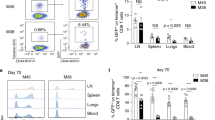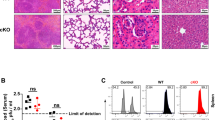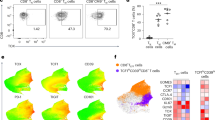Abstract
Naturally simian immunodeficiency virus (SIV)-infected sooty mangabeys do not progress to AIDS despite high-level virus replication. We previously showed that the fraction of CD4+CCR5+ T cells is lower in sooty mangabeys compared to humans and macaques. Here we found that, after in vitro stimulation, sooty mangabey CD4+ T cells fail to upregulate CCR5 and that this phenomenon is more pronounced in CD4+ central memory T cells (TCM cells). CD4+ T cell activation was similarly uncoupled from CCR5 expression in sooty mangabeys in vivo during acute SIV infection and the homeostatic proliferation that follows antibody-mediated CD4+ T cell depletion. Sooty mangabey CD4+ TCM cells that express low amounts of CCR5 showed reduced susceptibility to SIV infection both in vivo and in vitro when compared to CD4+ TCM cells of rhesus macaques. These data suggest that low CCR5 expression on sooty mangabey CD4+ T cells favors the preservation of CD4+ T cell homeostasis and promotes an AIDS-free status by protecting CD4+ TCM cells from direct virus infection.
This is a preview of subscription content, access via your institution
Access options
Subscribe to this journal
Receive 12 print issues and online access
$209.00 per year
only $17.42 per issue
Buy this article
- Purchase on SpringerLink
- Instant access to full article PDF
Prices may be subject to local taxes which are calculated during checkout






Similar content being viewed by others
References
Paiardini, M.P.I., Apetrei, C. & Silvestri, G. Lessons learned from the natural hosts of HIV-related viruses. Annu. Rev. Med. 60, 485–495 (2009).
Pandrea, I., Sodora, D.L., Silvestri, G. & Apetrei, C. Into the wild: simian immunodeficiency virus (SIV) infection in natural hosts. Trends Immunol. 29, 419–428 (2008).
Sodora, D.L. et al. Toward an AIDS vaccine: lessons from natural simian immunodeficiency virus infections of African nonhuman primate hosts. Nat. Med. 15, 861–865 (2009).
Gordon, S.N. et al. Severe depletion of mucosal CD4+ T cells in AIDS-free simian immunodeficiency virus-infected sooty mangabeys. J. Immunol. 179, 3026–3034 (2007).
Silvestri, G. et al. Divergent host responses during primary simian immunodeficiency virus SIVsm infection of natural sooty mangabey and nonnatural rhesus macaque hosts. J. Virol. 79, 4043–4054 (2005).
Bosinger, S.E. et al. Global genomic analysis reveals rapid control of a robust innate response in SIV-infected sooty mangabeys. J. Clin. Invest. 119, 3556–3572 (2009).
Harris, L.D. et al. Downregulation of robust acute type I interferon responses distinguishes nonpathogenic simian immunodeficiency virus (SIV) infection of natural hosts from pathogenic SIV infection of rhesus macaques. J. Virol. 84, 7886–7891 (2010).
Brenchley, J.M. et al. Differential TH17 CD4 T cell depletion in pathogenic and nonpathogenic lentiviral infections. Blood 112, 2826–2835 (2008).
Sumpter, B. et al. Correlates of preserved CD4+ T cell homeostasis during natural, nonpathogenic simian immunodeficiency virus infection of sooty mangabeys: implications for AIDS pathogenesis. J. Immunol. 178, 1680–1691 (2007).
Gordon, S.N. et al. Short-lived infected cells support virus replication in sooty mangabeys naturally infected with simian immunodeficiency virus: implications for AIDS pathogenesis. J. Virol. 82, 3725–3735 (2008).
Brenchley, J.M. et al. Microbial translocation is a cause of systemic immune activation in chronic HIV infection. Nat. Med. 12, 1365–1371 (2006).
Estes, J.D. et al. Early resolution of acute immune activation and induction of PD-1 in SIV-infected sooty mangabeys distinguishes nonpathogenic from pathogenic infection in rhesus macaques. J. Immunol. 180, 6798–6807 (2008).
Silvestri, G. et al. Nonpathogenic SIV infection of sooty mangabeys is characterized by limited bystander immunopathology despite chronic high-level viremia. Immunity 18, 441–452 (2003).
Douek, D.C., Roederer, M. & Koup, R.A. Emerging concepts in the immunopathogenesis of AIDS. Annu. Rev. Med. 60, 471–484 (2009).
Sodora, D.L. & Silvestri, G. Immune activation and AIDS pathogenesis. AIDS 22, 439–446 (2008).
Schindler, M. et al. Nef-mediated suppression of T cell activation was lost in a lentiviral lineage that gave rise to HIV-1. Cell 125, 1055–1067 (2006).
Mandl, J.N. et al. Divergent TLR7 and TLR9 signaling and type I interferon production distinguish pathogenic and nonpathogenic AIDS virus infections. Nat. Med. 14, 1077–1087 (2008).
Kornfeld, C. et al. Antiinflammatory profiles during primary SIV infection in African green monkeys are associated with protection against AIDS. J. Clin. Invest. 115, 1082–1091 (2005).
Estes, J.D. et al. Early resolution of acute immune activation and induction of PD-1 in SIV-infected sooty mangabeys distinguishes nonpathogenic from pathogenic infection in rhesus macaques. J. Immunol. 180, 6798–6807 (2008).
Pandrea, I. et al. Paucity of CD4+CCR5+ T cells is a typical feature of natural SIV hosts. Blood 109, 1069–1076 (2007).
Rey-Cuillé, M.A. et al. Simian immunodeficiency virus replicates to high levels in sooty mangabeys without inducing disease. J. Virol. 72, 3872–3886 (1998).
Pitcher, C.J. et al. Development and homeostasis of T cell memory in rhesus macaque. J. Immunol. 168, 29–43 (2002).
Paiardini, M. et al. Bone marrow–based homeostatic proliferation of mature T cells in nonhuman primates: implications for AIDS pathogenesis. Blood 113, 612–621 (2009).
Mummidi, S. et al. Production of specific mRNA transcripts, usage of an alternate promoter and octamer-binding transcription factors influence the surface expression levels of the HIV coreceptor CCR5 on primary T cells. J. Immunol. 178, 5668–5681 (2007).
Onlamoon, N. et al. Optimization of in vitro expansion of macaque CD4 T cells using anti-CD3 and co-stimulation for autotransfusion therapy. J. Med. Primatol. 35, 178–193 (2006).
Engram, J.C. et al. Lineage-specific T cell reconstitution following in vivo CD4+ and CD8+ lymphocyte depletion in non-human primates. Blood 116, 748–758 (2010).
Okoye, A. et al. Progressive CD4+ central memory T cell decline results in CD4+ effector memory insufficiency and overt disease in chronic SIV infection. J. Exp. Med. 204, 2171–2185 (2007).
Letvin, N.L. et al. Preserved CD4+ central memory T cells and survival in vaccinated SIV-challenged monkeys. Science 312, 1530–1533 (2006).
Mattapallil, J.J. et al. Vaccination preserves CD4 memory T cells during acute simian immunodeficiency virus challenge. J. Exp. Med. 203, 1533–1541 (2006).
Gautam, R. et al. In vitro characterization of primary SIVsmm isolates belonging to different lineages. In vitro growth on rhesus macaque cells is not predictive for in vivo replication in rhesus macaques. Virology 362, 257–270 (2007).
Zeng, M. et al. Cumulative mechanisms of lymphoid tissue fibrosis and T cell depletion in HIV-1 and SIV infections. J. Clin. Invest. 121, 998–1008 (2011).
Beaumier, C.M. et al. CD4 downregulation by memory CD4+ T cells in vivo renders African green monkeys resistant to progressive SIVagm infection. Nat. Med. 15, 879–885 (2009).
Riddick, N.E. et al. A novel CCR5 mutation common in sooty mangabeys reveals sivsmm infection of CCR5-null natural hosts and efficient alternative coreceptor use in vivo. PLoS Pathog. 6, e1001064 (2010).
Margolis, L. & Shattock, R. Selective transmission of CCR5-utilizing HIV-1: the 'gatekeeper' problem resolved? Nat. Rev. Microbiol. 4, 312–317 (2006).
Palacios, E. et al. Parallel evolution of CCR5-null phenotypes in humans and in a natural host of simian immunodeficiency virus. Curr. Biol. 8, 943–946 (1998).
Acknowledgements
We wish to thank L. Picker, D. Sodora and Z. Grossman for helpful discussions; F. Villinger, B. Lawson, F. Shaheen and J. Tilton for their technical support; and S. Ehnert and T. Meeker for their assistance with primate studies. We are grateful to the Emory Center for AIDS Research Virology Core and the Penn Center for AIDS Research Virology Core for their assistance. This work was supported by grant R01-AI66998 and P01-AI76074 (to G.S.), R56-AI087186 (to M.P.) and P51-RR-00165 (to Yerkes National Primate Research Center).
Author information
Authors and Affiliations
Contributions
M.P., B.C. and G.S. designed the study and wrote the paper, with contributions from the other authors as appropriate; M.P., B.C. and E.R.-A. performed the immunophenotypic analyses, analyzed results and prepared the figures; L.M., A.M.O., E.C. and A.C. helped in preparing the reagents, processing the samples and analyzing the data; C.V. and J.M.B. performed the quantitative PCR for SIV gag DNA; S.N.G. provided the data on experimentally SIV-infected sooty mangabeys and rhesus macaques; S.E.B. and N.F. determined CCR5 mRNA levels; P.L.H. performed the sorting experiments; T.S., M.L.C. and M.P.D. contributed to the design of the study and statistical analyses; J.E. supervised the housing and care of the primates and contributed to the design of the study and sample collection; J.M. and F.K. provided the eGFP-expressing SIV reporter virus; C.A., I.P., N.E.R., F.K. and R.G.C. contributed to the study design and preparation of the manuscript.
Corresponding authors
Ethics declarations
Competing interests
The authors declare no competing financial interests.
Supplementary information
Supplementary Text and Figures
Supplementary Figures 1 and 2 (PDF 1674 kb)
Rights and permissions
About this article
Cite this article
Paiardini, M., Cervasi, B., Reyes-Aviles, E. et al. Low levels of SIV infection in sooty mangabey central memory CD4+ T cells are associated with limited CCR5 expression. Nat Med 17, 830–836 (2011). https://doi.org/10.1038/nm.2395
Received:
Accepted:
Published:
Issue Date:
DOI: https://doi.org/10.1038/nm.2395
This article is cited by
-
Low CCR5 expression protects HIV-specific CD4+ T cells of elite controllers from viral entry
Nature Communications (2022)
-
Multivariate profiling of African green monkey and rhesus macaque T lymphocytes
Scientific Reports (2019)
-
HIV-1 targets L-selectin for adhesion and induces its shedding for viral release
Nature Communications (2018)
-
Species-specific host factors rather than virus-intrinsic virulence determine primate lentiviral pathogenicity
Nature Communications (2018)
-
Sooty mangabey genome sequence provides insight into AIDS resistance in a natural SIV host
Nature (2018)



